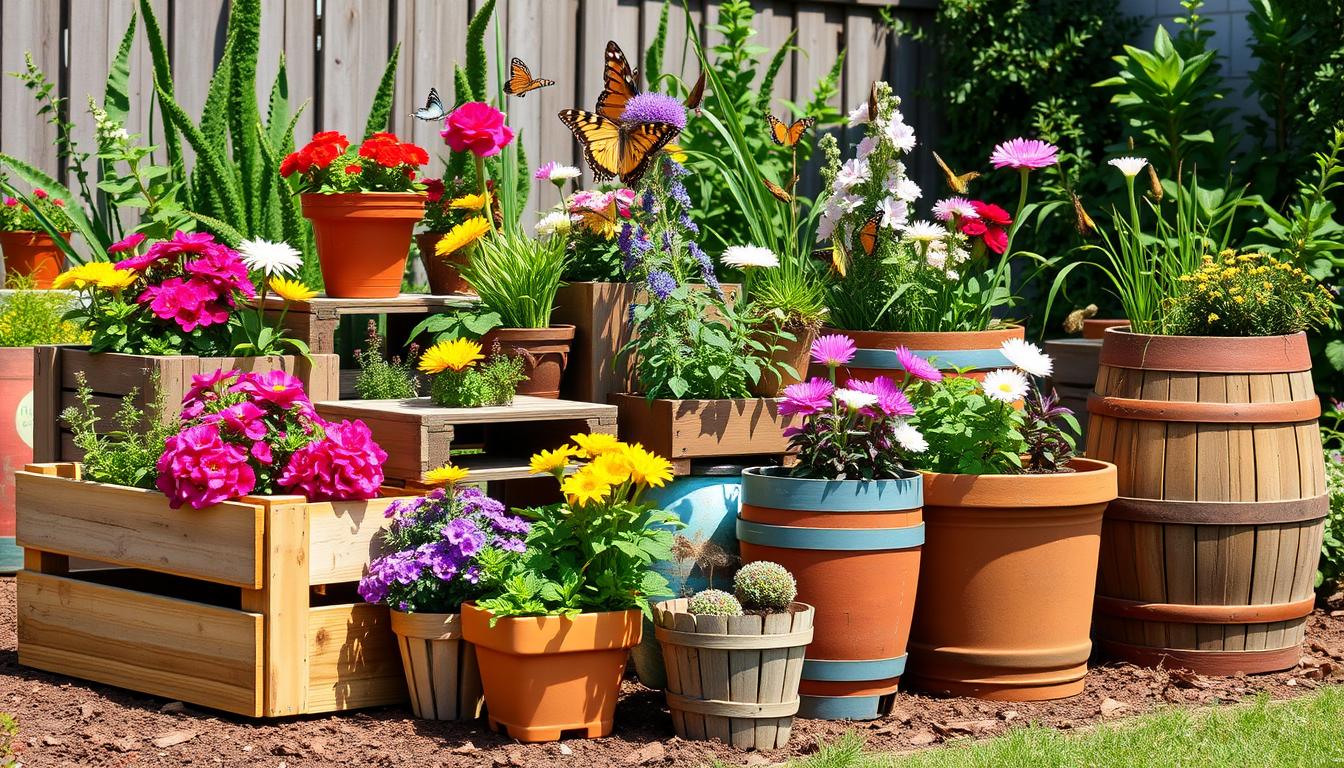I’m excited to share the world of DIY container garden projects with you. Here, you can make your own beautiful garden using easy projects and ideas. These fun and simple projects will help you unleash your green thumb and enjoy gardening.
I’ll guide you through picking the perfect plants and containers for your garden. Whether you’re new to gardening or have experience, you’ll find inspiration and tips here. These will help you start your container gardening journey.
DIY container garden projects let you add a personal touch to your outdoor space. You can enjoy gardening even if you have limited space. So, let’s dive into the world of container gardening ideas and projects. Together, we’ll create a beautiful and thriving garden.
Introduction to DIY Container Gardening
Starting with gardening can be easy with small space gardening. It’s great for beginners. You can turn even tiny spots into lush gardens. One big plus is controlling the soil, which is key for plants to grow well.
Container gardening has many perks, like less upkeep and more flexibility. You can move your containers to get the best light and warmth for your plants. This is super handy in cities where space is tight.
Why Choose Container Gardening?
Container gardening is ideal for those with little space or no experience. It lets you start small and try out different plants and soil. You can make a lovely garden on your balcony, patio, or indoors.
Benefits of Container Gardening
Container gardening offers several advantages:
- Improved soil quality and control
- Reduced maintenance and watering needs
- Increased flexibility and mobility
- Year-round gardening possibilities
Choosing container gardening means enjoying gardening’s perks without the usual challenges. It’s great for both newbies and seasoned gardeners. Small space gardening and urban projects can help you grow a beautiful garden.
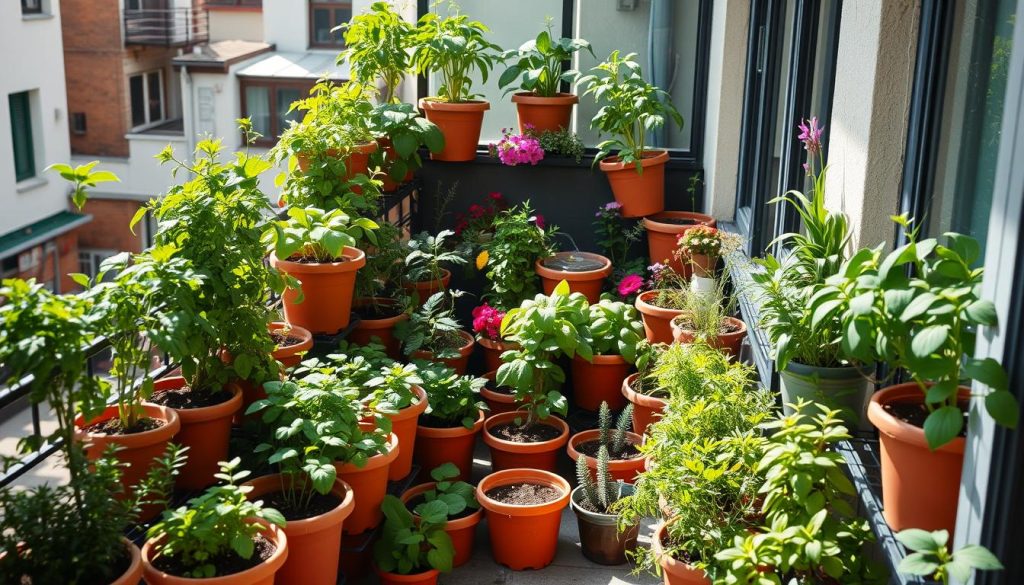
Essential Tools and Supplies for Container Gardening
Before starting your container garden, you need the right tools and supplies. As a beginner, it’s wise to invest in a few key items. This will help your plants grow well. You can find affordable garden projects to start with.
For creative planters, try using old containers like wooden crates or plastic tubs. You can also look online or in gardening stores for ideas. This will help you begin your container garden.
Must-Have Tools for Beginners
- Good quality potting mix
- Watering can
- Gardening gloves
Choosing the Right Containers
When picking containers, think about the plants you want and the space you have. Popular choices include plastic, ceramic, and wooden planters. With some research, you can find affordable options that match your style.
Here is a table summarizing some popular container options:
| Container Type | Pros | Cons |
|---|---|---|
| Plastic | Affordable, lightweight | May not be durable |
| Ceramic | Durable, attractive | May be heavy, expensive |
| Wooden | Natural, rustic look | May rot or decay |
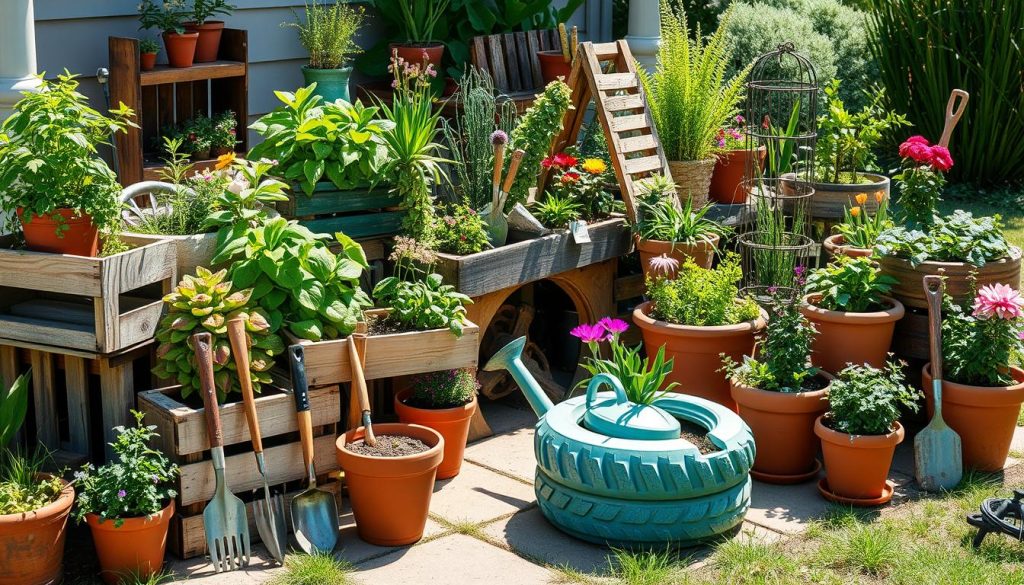
Selecting the Perfect Plants for Containers
Choosing the right plants for your container garden is key. As a beginner, pick plants that are easy to care for. Herbs like basil and mint, succulents like aloe and echeveria, and flowering plants like petunias and geraniums are great choices.
For urban gardening, look for plants that handle different lights and temperatures well. Herbs like rosemary and thyme are perfect for containers. Succulents like crassula and sedum are also great, needing little water.
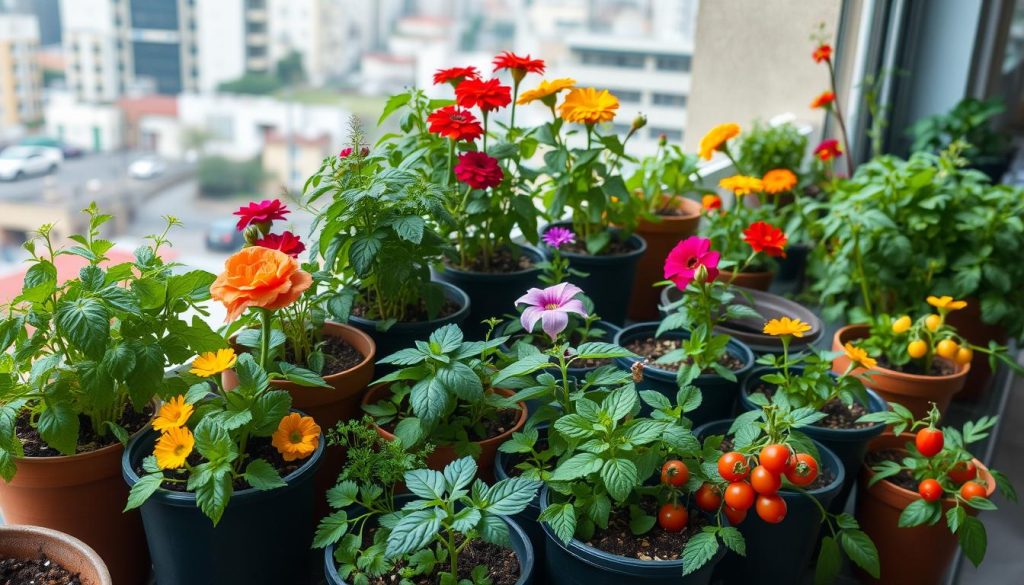
Best Plants for Beginners
- Herbs: basil, mint, rosemary, thyme
- Succulents: aloe, echeveria, crassula, sedum
- Flowering plants: petunias, geraniums, marigolds, zinnias
Seasonal Planting Ideas
Think about the season when planning your garden. In spring, plant cool-season crops like lettuce and spinach. Summer is for warm-season crops like tomatoes and peppers.
In fall, plant cool-season crops again. For winter, choose plants that can handle frost, like kale and cabbage.
Creative Container Ideas for Small Spaces
When gardening in small spaces, every inch matters. I enjoy finding creative ways to use planters. This includes vertical gardening, hanging planters, and window boxes to make the most of limited space.
Using trellises, arbors, and wall-mounted planters for vertical gardens is a favorite idea. These structures add beauty and provide a great spot for climbing plants like ivy and roses.
Vertical Gardening Techniques
Vertical gardening is popular for small spaces. You can use trellises or arbors for climbing plants or wall-mounted planters for wall greenery. Mixing both can create a stunning display.
Hanging Planters and Window Boxes
Hanging planters and window boxes bring charm to small spaces. Look for planters made for small spaces, like self-watering ones. They prevent water spills.
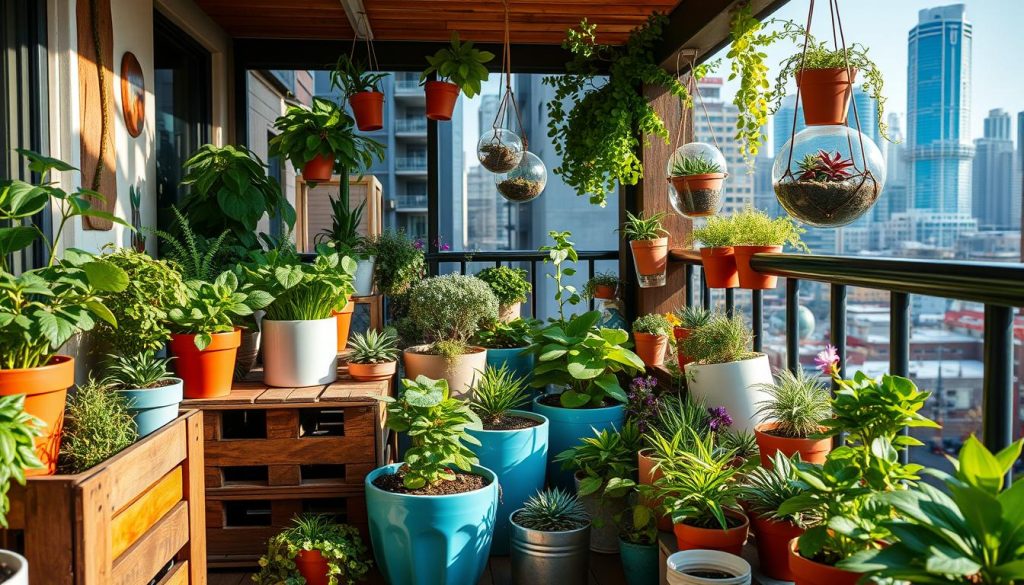
Other creative ideas include using recycled materials like old pallets for planters. Or, try a living wall planter for wall greenery. With creativity, even small spaces can become vibrant gardens.
| Planter Type | Benefits | Space Requirements |
|---|---|---|
| Trellis | Supports climbing plants, adds visual interest | Minimal floor space required |
| Wall-Mounted Planter | Adds greenery to walls, space-saving | No floor space required |
| Hanging Planter | Adds visual interest, space-saving | Minimal floor space required |
DIY Self-Watering Containers
Starting with container gardening can be tough, especially with watering. But, self-watering containers make it easier. They’re perfect for beginners because they’re easy to make and don’t cost much.
Creating a Self-Watering System
To make a self-watering system, you need a few things. You’ll need a container, a water reservoir, and a wicking material. You can use a plastic bottle or a wooden box for the container. For the reservoir, try a plastic tray or a sponge.
The wicking material pulls water from the reservoir to the soil. This keeps your plants watered all the time.
Benefits of Self-Watering Containers
Self-watering containers have many advantages. They save you from having to water plants all the time. They also help your plants stay healthy. Plus, they’re great for people who forget to water their plants.
They’re also easy on your wallet because you can make them from things you already have. This means you don’t have to spend a lot of money.
Here are some tips for making self-watering containers:
- Make sure your container is big enough for the soil and water.
- Pick a wicking material that works well for your plants.
- Check the water level in the reservoir often to avoid running out.
With these tips, you can make your own self-watering containers. This will help you enjoy gardening more. Remember to pick projects that fit your skills and budget. Don’t be afraid to try new things and get creative.
| Container Size | Water Reservoir Size | Wicking Material |
|---|---|---|
| Small | 1-2 cups | Cotton rope or sponge |
| Medium | 2-4 cups | Wicking fabric or felt |
| Large | 4-6 cups | Wicking material or sponge |
Upcycling Household Items into Planters
Exploring container gardening, I found joy in upcycling household items. It’s a creative way to reduce waste and add a personal touch to my garden. Old plastic bottles, cardboard tubes, and wooden crates can become unique planters for small spaces.
Upcycling is great because it saves money on gardening. I repurpose items I’d otherwise throw away. This way, I can spend more on plants and try out different creative ideas.
When upcycling, safety is key. I clean and disinfect items before using them as planters. This step keeps my plants healthy and pest-free, ensuring a safe and thriving garden.
Fun Ideas for Reusing Old Containers
- Plastic bottles: Cut the bottom off and use as a self-watering planter
- Cardboard tubes: Transform into biodegradable planters for seedlings
- Wooden crates: Upcycle into planters for herbs or succulents
Safety Considerations for Upcycled Planters
By following these steps and considering safety, I can create a beautiful garden. Upcycling reduces waste and lets me express my creativity. My garden becomes a true reflection of me.
| Upcycled Item | Planter Idea | Safety Consideration |
|---|---|---|
| Plastic bottles | Self-watering planter | Clean and disinfect before use |
| Cardboard tubes | Biodegradable planter | Avoid using tubes with toxic coatings |
| Wooden crates | Planter for herbs or succulents | Ensure crates are free from pests and diseases |
Designing Your Container Garden Layout
Exploring container gardening, I’ve learned it’s not just about picking plants. It’s also about making your garden look good. Small space gardening can be tough, but the right design can make it stunning.
First, think about what you want your garden to look like. Consider the colors, textures, and shapes of your plants and decorations. For instance, mix tall and short plants for a layered effect. Or group plants with similar textures for a unified look.
Arranging Your Plants for Visual Appeal
Here are some tips for arranging your plants:
- Put plants with similar needs together for easier care
- Use plants of different heights and textures for depth
- Make sure plants have enough space for air and growth
Incorporating Color and Texture
To add color and texture, use different plants, containers, and decorations. Bright pots can add color, or a sculpture can draw the eye. These elements can make your garden interesting.
By following these tips, you can make a beautiful container garden. It will show off your style and flair, even in a small space.
Seasonal Container Garden Projects
As the seasons change, I love to update my container garden. I follow the latest trends and themes. With creativity, you can make beautiful and thriving gardens for each season. For spring, try pastel-colored pots and planters with blooming flowers and greenery.
In small spaces, every inch matters. Use vertical planters and hanging baskets to add depth and interest. Some top spring ideas include:
- Planting a mix of colorful flowers and herbs in a large planter
- Creating a succulent garden in a small, shallow container
- Using a trellis to train climbing plants like ivy or clematis
In fall and winter, your container garden can still be enjoyed. Use seasonal plants and decorations. Try fall-themed planters with seasonal flowers, branches, and berries. For winter, use evergreen branches, holly, and pinecones for a festive feel. With planning and creativity, enjoy your garden all year.
Pest Control in Container Gardens
Starting with container gardening means learning about pest control. It’s key to keep your plants safe. Natural methods are easy and won’t cost much. For instance, neem oil or soap solution can keep pests away.
Simple ways to fight pests include making barriers and using companion planting. Some plants can keep pests away from others.
Natural Pest Management Techniques
- Use neem oil to repel pests
- Create physical barriers to prevent pests from reaching your plants
- Use companion planting to deter pests
Common Pests to Watch For
Watch out for aphids, whiteflies, and spider mites in your garden. These pests can harm your plants a lot. Natural methods and knowing these pests can help keep your garden healthy.
Follow these tips for a successful garden. Always check your plants for pests and act fast to stop damage.
| Pest | Description | Control Method |
|---|---|---|
| Aphids | Small, soft-bodied insects | Neem oil or soap solution |
| Whiteflies | Small, winged insects | Physical barriers or companion planting |
| Spider mites | Small, spider-like insects | Neem oil or soap solution |
Watering Techniques for Container Gardens
Exploring container gardening, I’ve learned watering is key to keeping plants healthy. In easy gardening projects, the right watering makes a big difference. In small space gardening, it’s crucial to water just right, as too much or too little can harm plants.
In urban gardening, saving water is important. I’ve tried self-watering containers and drip irrigation. These methods help water reach the roots, cutting down on evaporation and runoff.
- Using soaker hoses to water the soil directly
- Following a watering schedule for consistency
- Checking soil moisture to prevent overwatering
These strategies help me keep my container garden healthy, even in the city. Whether you’re new to gardening or experienced, try these projects. Discover the joy of growing your own urban garden.
Maintaining Your Container Garden
Starting with container gardening? It’s key to know how to keep your plants healthy. With a bit of effort, you can learn to care for your garden. This is true even if you’re working with a small space or a tight budget.
Routine Maintenance Tips
To keep your garden looking great, fertilize your plants often. Also, prune them to keep their shape and repot when needed. Here are more tips to remember:
- Water your plants when the soil feels dry to the touch
- Provide your plants with enough sunlight and shade
- Watch for pests or diseases on your plants
Signs Your Plants Need Attention
Notice any of these signs? It might mean your plants need some care:
- Yellowing leaves or droopy stems
- Pest infestations or fungal growth
- Lack of new growth or blooms
Sharing My Container Gardening Journey
Looking back, I’m proud of my container gardening journey. I started with no idea what to do. But through trying and failing, I’ve learned a lot.
Lessons Learned Along the Way
Patience and perseverance are key. Growing a great container garden takes time and effort. I’ve faced many challenges, like plants not doing well and pests. But each problem taught me something.
Celebrating My Gardening Successes
The joys of container gardening far outweigh the struggles. Seeing my plants grow and bloom is incredibly rewarding. I’m proud of the beautiful gardens I’ve made.
As I keep gardening, I want to share my journey with others. Container gardening is full of easy projects. I’m grateful for every lesson and success I’ve had.

